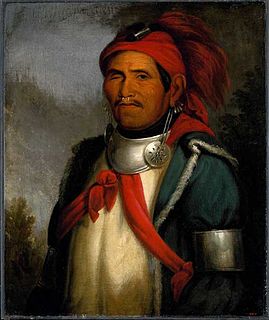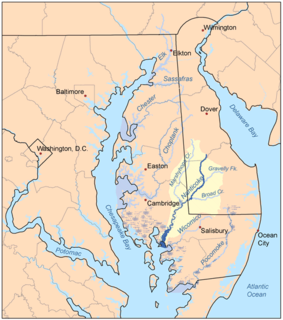
The Lenape, also called the Leni Lenape, Lenni Lenape and Delaware people, are an indigenous people of the Northeastern Woodlands, who live in Canada and the United States. Their historical territory included present-day New Jersey and eastern Pennsylvania along the Delaware River watershed, New York City, western Long Island, and the Lower Hudson Valley. Today, Lenape people belong to the Delaware Nation and Delaware Tribe of Indians in Oklahoma; the Stockbridge-Munsee Community in Wisconsin; and the Munsee-Delaware Nation, Moravian of the Thames First Nation, and Delaware of Six Nations in Ontario.

A mountain man is an explorer who lives in the wilderness. Mountain men were most common in the North American Rocky Mountains from about 1810 through to the 1880s. They were instrumental in opening up the various Emigrant Trails allowing Americans in the east to settle the new territories of the far west by organized wagon trains traveling over roads explored and in many cases, physically improved by the mountain men and the big fur companies originally to serve the mule train based inland fur trade.

The Shawnee are an Algonquian-speaking ethnic group indigenous to North America. In colonial times they were a semi-migratory Native American nation, primarily inhabiting areas of the Ohio Valley, extending from what became Ohio and Kentucky eastward to West Virginia, Virginia, Pennsylvania, and Western Maryland; south to Alabama and South Carolina; and westward to Indiana, and Illinois.

The Kittanning Path was a major east-west Native American trail that crossed the Allegheny Mountains barrier ridge connecting the Susquehanna River valleys in the center of Pennsylvania to the highlands of the Appalachian Plateau and thence to the western lands beyond drained by the Ohio River. Kittanning Village was the first major Delaware (Lenape) Indian settlement along the descent from the Allegheny Plateau.

James Pierson Beckwourth, born James Beckwith and generally known as, Jim Beckwourth was an American mountain man, fur trader, and explorer. James was also famously known as "Bloody Arm" because of his skill as a fighter. He was mixed-race and born into slavery in Virginia. He was freed by his white father, and apprenticed to a blacksmith so that he could learn a trade.

The Gnadenhutten massacre, also known as the Moravian massacre, was the killing of 96 Christian Delaware by U.S. militiamen from Pennsylvania on March 8, 1782 at the Moravian missionary village of Gnadenhutten, Ohio during the American Revolutionary War. More than a century later, Theodore Roosevelt called the massacre "a stain on frontier character that the lapse of time cannot wash away".
White Eyes, named Koquethagechton, was a leader of the Lenape (Delaware) people in the Ohio Country during the era of the American Revolution. Sometimes known as George White Eyes, or Captain Grey Eyes al. Sir William, his given name in Lenape was rendered in many spelling variations in colonial records.
Buckongahelas was a regionally and nationally renowned Lenape chief, councilor and warrior. He was active from the days of the French and Indian War through the Northwest Indian Wars, after the United States achieved independence and settlers encroached on territory beyond the Appalachian Mountains and Ohio River. He became involved in the Western Confederacy of mostly Algonquian-speaking peoples, who were seeking to repel American settlers. The chief led his Lenape band from present-day Delaware westward, eventually to the White River area of present-day Muncie, Indiana. One of the most powerful war chiefs on the White River, Buckongahelas was respected by the Americans as a chief, although he did not have the position to do political negotiations.

The Light in the Forest is a novel first published in 1953 by U.S. author Conrad Richter. Though it is a work of fiction and primarily features fictional characters, the novel incorporates historic figures and is based in historical fact related to the late eighteenth century and period of the American Revolutionary War.

The Nanticoke people are an indigenous American Algonquian people, whose traditional homelands are in Chesapeake Bay and Delaware. Today they live in the northeast United States and Canada, especially Delaware; in Ontario; and in Oklahoma.

Abraham Lincoln was the grandfather of the 16th U.S. president, Abraham Lincoln. Lincoln was a military captain during the American Revolution, and a pioneer settler of Kentucky.

Captain Pipe (Lenape), called Konieschquanoheel and also known as Hopocan, was an 18th-century chief of the Algonquian-speaking Lenape (Delaware) and a member of the Wolf Clan. He was a warrior and by 1773 succeeded his maternal uncle Custaloga as chief, part of a group that had moved from Pennsylvania to Ohio around the time of the French and Indian War.
Captain Robert Benham, was a frontier pioneer, served in local government and was a member of the first elected legislature for the State in Ohio, 1799 & 1800.

Indian removals in Indiana followed a series of the land cession treaties made between 1795 and 1846 that led to the removal of most of the native tribes from Indiana. Some of the removals occurred prior to 1830, but most took place between 1830 and 1846. The Lenape (Delaware), Piankashaw, Kickapoo, Wea, and Shawnee were removed in the 1820s and 1830s, but the Potawatomi and Miami removals in the 1830s and 1840s were more gradual and incomplete, and not all of Indiana’s Native Americans voluntarily left the state. The most well-known resistance effort in Indiana was the forced removal of Chief Menominee and his Yellow River band of Potawatomi in what became known as the Potawatomi Trail of Death in 1838, in which 859 Potawatomi were removed to Kansas and at least forty died on the journey west. The Miami were the last to be removed from Indiana, but tribal leaders delayed the process until 1846. Many of the Miami were permitted to remain on land allotments guaranteed to them under the Treaty of St. Mary's (1818) and subsequent treaties.

Teedyuscung was known as King of the Delawares. He worked to establish a permanent Lenape (Delaware) home in eastern Pennsylvania in the Lehigh, Susquehanna and Delaware River valleys. Teedyuscung participated in the Treaty of Easton which resulted in the loss of any Lenape claims to all lands in Pennsylvania. Following the treaty the Lenape were forced to live under the control of the Iroquois in the Wyoming Valley near modern-day Wilkes-Barre. Teedyuscung was murdered by arsonists on April 19, 1763 as he reportedly lay asleep as his cabin burned around him. This marked the beginning of the end of the Lenape presence in Pennsylvania. Teedyuscung's son Chief Bull conducted a raid on the Wyoming Valley that was part of a greater Indian uprising that resulted in the Lenape being forced to move west of the Appalachian Mountains by the Royal Proclamation of 1763.
Anthony Sadowski was a Polish-born Indian trader and interpreter employed by the provincial governor of Pennsylvania as an Indian agent in the western country.
Lenape settlements are villages and other sites founded by Lenape people, a Native American tribe from the Northeastern Woodlands. Many of these sites are located in Ohio.
John Brickell was an early settler of Franklin County, Ohio who was abducted by the Lenape Tribe in 1791. For four years, Brickell lived among the Lenape tribe. Brickell was released as a result of the Treaty of Greenville in August 1795. A monument in Columbus, Ohio marks the location of Brickell's cabin.






















